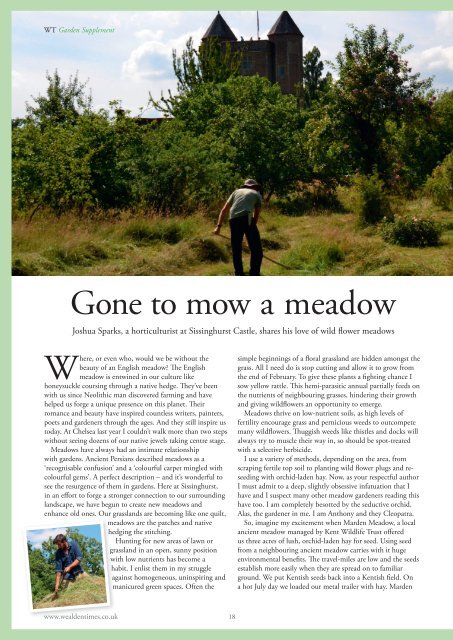Wealden Times | WT170 | April 2016 | Garden supplement inside
Wealden Times - The lifestyle magazine for the Weald
Wealden Times - The lifestyle magazine for the Weald
Create successful ePaper yourself
Turn your PDF publications into a flip-book with our unique Google optimized e-Paper software.
WT <strong>Garden</strong> Supplement<br />
Gone to mow a meadow<br />
Joshua Sparks, a horticulturist at Sissinghurst Castle, shares his love of wild flower meadows<br />
Where, or even who, would we be without the<br />
beauty of an English meadow? The English<br />
meadow is entwined in our culture like<br />
honeysuckle coursing through a native hedge. They’ve been<br />
with us since Neolithic man discovered farming and have<br />
helped us forge a unique presence on this planet. Their<br />
romance and beauty have inspired countless writers, painters,<br />
poets and gardeners through the ages. And they still inspire us<br />
today. At Chelsea last year I couldn’t walk more than two steps<br />
without seeing dozens of our native jewels taking centre stage.<br />
Meadows have always had an intimate relationship<br />
with gardens. Ancient Persians described meadows as a<br />
‘recognisable confusion’ and a ‘colourful carpet mingled with<br />
colourful gems’. A perfect description – and it’s wonderful to<br />
see the resurgence of them in gardens. Here at Sissinghurst,<br />
in an effort to forge a stronger connection to our surrounding<br />
landscape, we have begun to create new meadows and<br />
enhance old ones. Our grasslands are becoming like one quilt,<br />
meadows are the patches and native<br />
hedging the stitching.<br />
Hunting for new areas of lawn or<br />
grassland in an open, sunny position<br />
with low nutrients has become a<br />
habit. I enlist them in my struggle<br />
against homogeneous, uninspiring and<br />
manicured green spaces. Often the<br />
simple beginnings of a floral grassland are hidden amongst the<br />
grass. All I need do is stop cutting and allow it to grow from<br />
the end of February. To give these plants a fighting chance I<br />
sow yellow rattle. This hemi-parasitic annual partially feeds on<br />
the nutrients of neighbouring grasses, hindering their growth<br />
and giving wildflowers an opportunity to emerge.<br />
Meadows thrive on low-nutrient soils, as high levels of<br />
fertility encourage grass and pernicious weeds to outcompete<br />
many wildflowers. Thuggish weeds like thistles and docks will<br />
always try to muscle their way in, so should be spot-treated<br />
with a selective herbicide.<br />
I use a variety of methods, depending on the area, from<br />
scraping fertile top soil to planting wild flower plugs and reseeding<br />
with orchid-laden hay. Now, as your respectful author<br />
I must admit to a deep, slightly obsessive infatuation that I<br />
have and I suspect many other meadow gardeners reading this<br />
have too. I am completely besotted by the seductive orchid.<br />
Alas, the gardener in me. I am Anthony and they Cleopatra.<br />
So, imagine my excitement when Marden Meadow, a local<br />
ancient meadow managed by Kent Wildlife Trust offered<br />
us three acres of lush, orchid-laden hay for seed. Using seed<br />
from a neighbouring ancient meadow carries with it huge<br />
environmental benefits. The travel-miles are low and the seeds<br />
establish more easily when they are spread on to familiar<br />
ground. We put Kentish seeds back into a Kentish field. On<br />
a hot July day we loaded our metal trailer with hay. Marden<br />
www.wealdentimes.co.uk<br />
18<br />
06<strong>WT170</strong>Supplement.indd 18 23/03/<strong>2016</strong> 18:49


















